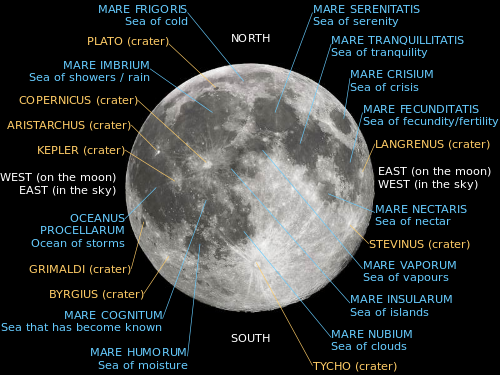- Mare Serenitatis
-
Mare Serenitatis 
Photograph of Mare SerenitatisCoordinates 28°00′N 17°30′E / 28.0°N 17.5°ECoordinates: 28°00′N 17°30′E / 28.0°N 17.5°E Diameter 674 km (419 mi)[1][2] Eponym Sea of Serenity Mare Serenitatis (the "Sea of Serenity") is a lunar mare that sits just to the east of Mare Imbrium on the Moon.
It is located within the Serenitatis basin, which is of the Nectarian epoch. The material surrounding the mare is of the Lower Imbrian epoch, while the mare material is of the Upper Imbrian epoch. The mare basalt covers a majority of the basin and overflows into Lacus Somniorum to the northeast. The most noticeable feature is the crater Posidonius on the northeast rim of the mare.[3] The ring feature to the west of the mare is indistinct, except for Montes Haemus. Mare Serenitatis connects with Mare Tranquillitatis to the southeast and borders Mare Vaporum to the southwest. Mare Serenitatis is one example of a mascon, an anomalous gravitational region on the moon.
Mare Serenitatis is Latin for Sea of Serenity (or Sea of Peacefulness).
Both Luna 21 and Apollo 17 landed near the east border of Mare Serenitatis, in the area of the Montes Taurus range.
In popular culture
Mare Serenitatis forms one of the eyes for the Man in the Moon.
In Sailor Moon, Mare Serenitatis was the former location of the Moon Kingdom.
Mare Serenitatis is also mentioned in Arthur C. Clarke's The Sentinel.
References
- ^ "Moon Mare/Maria". Gazetteer of Planetary Nomenclature. USGS Astrogeology. http://planetarynames.wr.usgs.gov/SearchResults?target=MOON&featureType=Mare%2C%20maria. Retrieved 2010-08-20.
- ^ "Mare Serenitatis". NASA Lunar Atlas. http://lunar.arc.nasa.gov/science/atlas/mare/mserenitatis.htm. Retrieved 2009-07-04.
- ^ "Lunar Map". Central Coast Astronomical Society. http://www.ccastronomy.org/photo_tour_Moon_Map.jpg. Retrieved 2009-07-04.[dead link]
Lunar maria Mare Oceanus Lacus Sinus Paludes Categories:- LQ12 quadrangle
- Maria on the Moon
Wikimedia Foundation. 2010.


